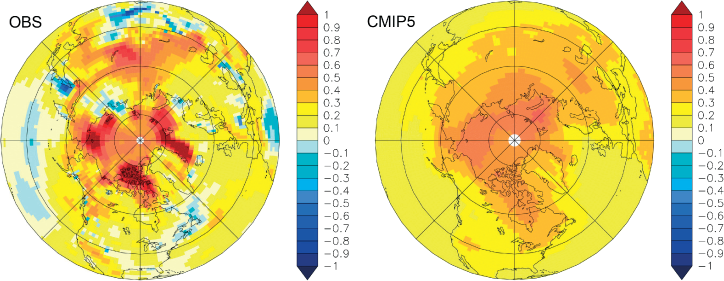What you read in the IPCC Fifth Assessment Report (5AR) regarding sea level rise this century, a maximum 0.98 m rise by 2100 based on RCP 8.5, the worst case scenario, (5AR, page 1204) ain't necessarily so. There is good reason for this. The material published in 5AR is based on some of the best scientific information available prior to publication in 2013. It represents a consensus view among contributing scientists. As such, it inevitably presents a comprehensive though conservative view, providing what the IPCC believes is a sound basis for reliable public policy formulation. But is it?
Every aspect of climate change contributes to mean global sea level but the two most significant causing it to rise are melting of land-based ice and thermal expansion of seawater. Both are caused by global warming, particularly warming in polar regions where most land-based ice is located. So you would think that the IPCC would pay particular attention to ensuring the accuracy of its prognosis for global warming in general and polar warming in particular. But does it?
Can we, should we, rely on its assertion that mean global sea level will rise 0.52-0.98m by 2100,Figure SPM9 (pdf), for the worst case scenario (RCP8.5), as a sound basis for public policy, particularly regarding the location and protection of buildings and other infrastructure in coastal areas?
Advertisement
Arctic Warming
The IPCC is well aware that the Arctic is undergoing abrupt climate change (abrupt even on a human life-span scale) in the form of atmosphere and ocean warming. This has resulted in accelerating ice mass loss from the Greenland ice sheet (GIS), exacerbated by aerosol deposits (soot, dust, ash etc) on both sea ice and much of the GIS. It recognises that loss of Arctic sea ice will reduce albido, increase ocean warming and further hasten melting of the GIS.
However The IPCC appears to be wrong about the speed with which sea ice loss will occur or other factors contributing to Arctic Ocean warming. These include strengthening convection currents accelerating sub-sheet penetration by warmer water and its effect on rate of ice mass loss from the GIS, the more vulnerable marine West Antarctic ice sheet (WAIS) and glaciers of the East Antarctic Ice sheet (EAIS).
Consider IPCC reliance on CMIP5, an assembly of 36 global climate models, to determine Arctic amplification which conclude that Arctic warming is likely to occur at ~x2 the rate of present average global warming. Using observed data rather than climate model (CMIP5) outcomes,(Overland et al (2014) indicate that Arctic amplification could be in the order of x3 - x4 average global surface warming possibly reaching +13°C by 2100 with business as usual (RCP 8.5) greenhouse gas emissions.

Fig. 1 Annual mean surface air temperature for 1966–2005 period based on NCEP/NCAR reanalysis of observed data (left) and ensemble mean of 36 CMIP5 models. Units are °C/decade.Source: Overland et al (2014).
Advertisement
The IPCC 5AR relies on CMIP5 projections which underestimate observed warming but is nevertheless used as the basis for calculating future Arctic amplification and its effects on loss of albedo, surface air temperature, Arctic Ocean warming and their effects on ice mass loss from the GIS and consequential sea level rise.
Methane GWP
The global warming potential of CH4 is still quoted by some as being "over 20" and "25 times" that of CO2 over a 100 year period, the latter being a value routinely used in 2016 by the U.S. EPA. This is wrong, and dangerously misleading when it comes to determining the effects of methane on average global temperature and SLR. The IPCC's 5AR more accurately describes CH4 as having GWP of 34, Table 8.7 (pdf) but even this may be an underestimate. Why so?
Discuss in our Forums
See what other readers are saying about this article!
Click here to read & post comments.
27 posts so far.